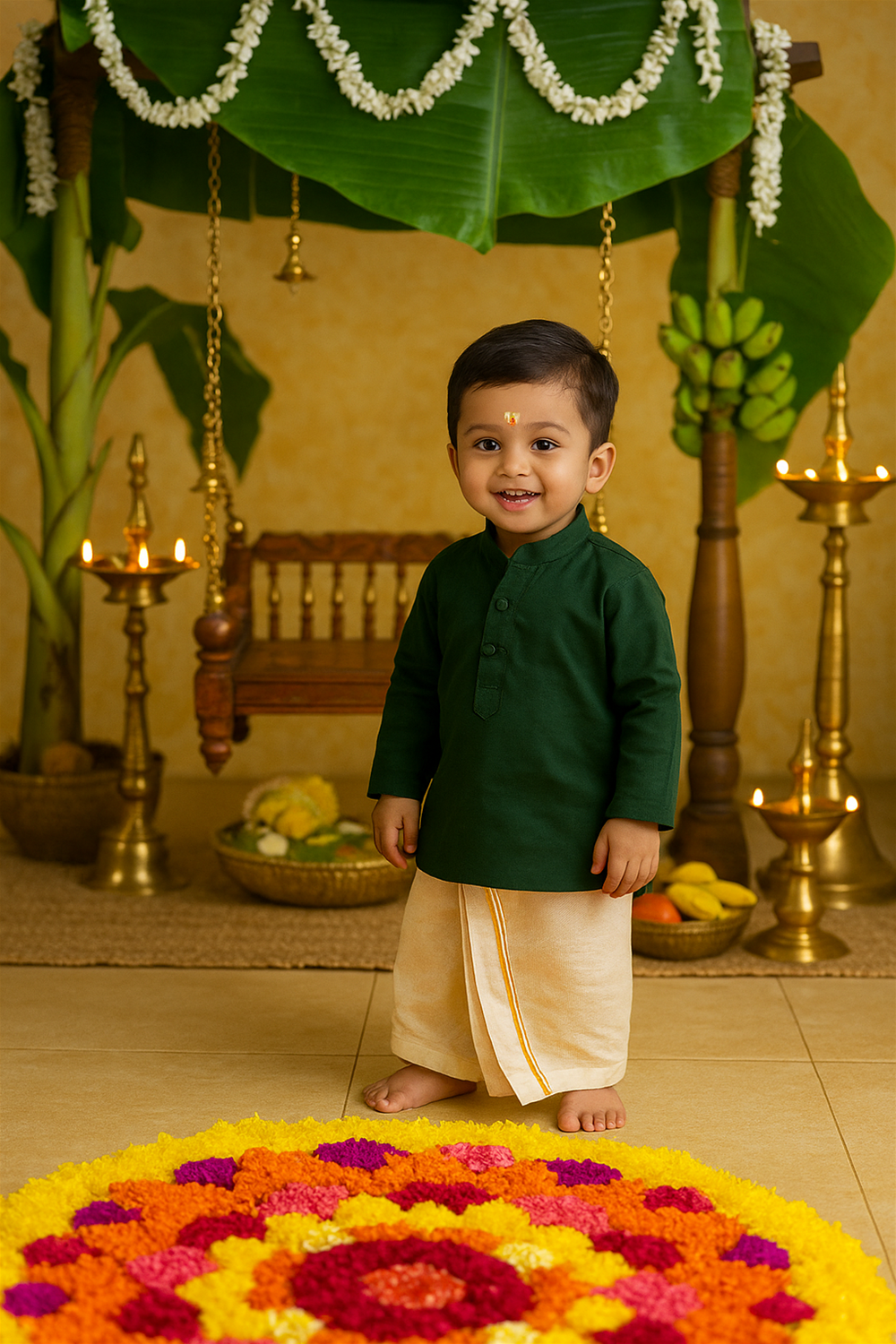
27455 Boys Linen Cotton Bottle Green Kurtha in Full Sleeves
Send With EMS Speed Post
Flexible returns
The child wears a traditional South Indian festive outfit featuring a deep green cotton kurta with a stand collar, full sleeves, and a half-button placket, paired with an ivory mundu adorned with a golden kasavu border. Designed for comfort and elegance, the breathable fabrics and simple tailoring keep the look culturally authentic while allowing freedom of movement—ideal for Onam celebrations, temple visits, or other traditional gatherings.
-
Overall Outfit Style
The child is wearing a traditional South Indian festive attire suitable for cultural events like Onam, temple visits, or weddings. The combination includes a deep green kurta and an ivory-white veshti/mundu (dhoti) with a golden border, creating a vibrant yet elegant appearance. This style is symbolic of Kerala’s cultural heritage, blending comfort, tradition, and visual charm. -
Kurta Color
The kurta is in a rich, deep forest green shade. This color stands out beautifully against the lighter bottom garment, giving the outfit a balanced and festive contrast. Green also holds cultural significance, often associated with freshness, prosperity, and auspicious beginnings, making it an apt choice for celebratory occasions. -
Kurta Fabric
The kurta appears to be crafted from a lightweight, breathable cotton or a cotton-blend fabric. This material is comfortable for children, especially in warm climates, and drapes neatly without stiffness. Cotton also absorbs moisture well, allowing the wearer to remain cool during traditional gatherings or rituals. -
Kurta Neck Design
The neckline is a short stand collar, often called a Mandarin collar or bandhgala, which adds a touch of formality while maintaining a clean, minimal look. This collar style is common in Indian festive wear and eliminates the need for heavy embellishments, keeping the attire comfortable for children. -
Kurta Front Placket
The front features a half-button placket with three matching fabric-covered buttons. This half-placket style is not only aesthetically pleasing but also practical for dressing toddlers, as it provides enough opening for the head while retaining a snug fit at the collar. -
Kurta Sleeves
The kurta has full-length sleeves, offering a traditional touch and ensuring modest coverage. The sleeves are slightly loose, allowing ease of movement for playful or active children during festive events. -
Kurta Hemline
The hemline of the kurta falls just below the waist, complementing the dhoti length without overshadowing it. The straight cut maintains a clean silhouette, making the outfit look well-tailored while allowing room for movement. -
Bottom Garment Type
The child is wearing a mundu or veshti — a traditional Kerala-style lower garment. For children, it is often pre-stitched or partially stitched to make it easy to wear, unlike the unstitched adult version. This piece retains the authentic look while offering practicality for a toddler. -
Bottom Garment Color
The mundu is ivory or off-white in color, a shade deeply rooted in Kerala’s traditional dress codes for festivals and temple rituals. This light tone serves as a neutral canvas for the golden border, ensuring that the outfit’s elegance shines through. -
Golden Border (Kasavu)
A striking feature of the mundu is the golden kasavu border, woven into the edge. This metallic gold trim is symbolic of Kerala’s heritage and is often featured in festive attire, adding a touch of regal elegance without overwhelming the simplicity of the white base fabric. -
Fabric of the Mundu
Like the kurta, the mundu seems to be made from cotton or a cotton-silk blend, which is lightweight, breathable, and comfortable for children. Cotton ensures coolness, while a subtle silk blend can add a soft sheen, enhancing the festive vibe. -
Fit and Draping
The fit is relaxed, ensuring the child’s comfort during long hours of celebration. The mundu is folded neatly in front, and the length is appropriate for the toddler, preventing tripping hazards while still looking traditional. -
Accessories and Styling
While the child is not wearing heavy accessories, a small decorative bindi (tilak) is placed on the forehead, adding a cultural and auspicious touch. The minimal styling ensures the focus remains on the attire and the child’s cheerful expression. -
Cultural Context
This outfit combination is iconic in Kerala during festivals like Onam, Vishu, and temple ceremonies. The green kurta adds a modern touch to the otherwise traditional white-and-gold attire, creating a blend of contemporary and cultural style for younger generations. -
Practical Considerations for Children’s Wear
The choice of breathable fabrics, minimal embellishments, and simple construction reflects an understanding of a toddler’s needs. The design allows the child to move, play, and participate in rituals without discomfort, while still being dressed appropriately for a formal cultural celebration.


